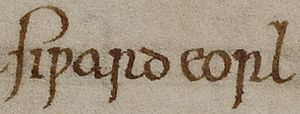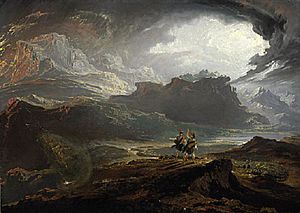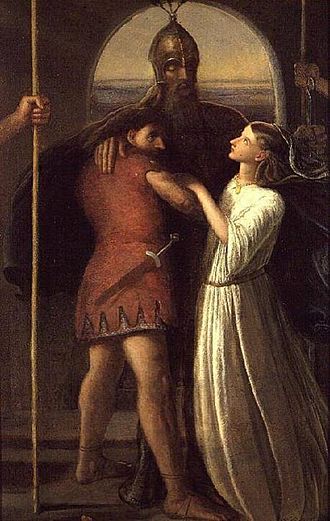Siward, Earl of Northumbria facts for kids
Quick facts for kids SiwardSigvarðr Diger |
|
|---|---|

Siƿard eorl (spelled with a wynn) in a manuscript of the Anglo-Saxon Chronicle (c. 1200)
|
|
| Earl of Northumbria | |
| Reign | 1041–55 |
| Earl in York | |
| Reign | from 1023–33 |
| Predecessor | Erik of Hlathir (for York) Eadwulf (for Bamburgh) Uhtred the Bold (for both) |
| Successor | Tostig Godwinson |
| Born | Scandinavia |
| Died | 1055 |
| Burial | St Olave's Church, York |
| Wives | Ælfflæd Godgifu |
| Issue | Osbjorn (unclear) Waltheof (Ælfflæd) |
| Father | Bjorn (?) |
Siward (pronounced SOO-werd or SEE-werd), also known as Sigurd the Stout, was a very important leader in northern England during the 11th century. His nickname Digri in Old Norse and Grossus in Latin both mean "the stout" or "the strong". Siward might have come from Scandinavia (like modern-day Norway, Sweden, or Denmark) or had mixed Scandinavian and English roots.
He became a powerful figure in England when Cnut the Great ruled (1016–1035). Cnut was a Scandinavian king who took over most of England. Siward was one of many Scandinavians who came to England around this time. He rose to become a major ruler in northern England. By 1033, he was in charge of southern Northumbria, which is now Yorkshire, acting as an earl for King Cnut.
Siward made his power stronger by marrying Ælfflæd, whose father was Ealdred II of Bamburgh, another important earl. After Siward killed Ealdred's successor, Eadwulf IV of Bamburgh, in 1041, he gained control of all Northumbria. He helped Cnut's later kings, Harthacnut and Edward the Confessor, with important military support and advice. He also likely took control of the middle areas of Northampton and Huntingdon by the 1050s. There's also some evidence he expanded Northumbrian control into Cumberland.
In the early 1050s, Siward fought against the Scottish king Mac Bethad mac Findlaích, often called Macbeth. Even though his son Osbjorn died, Siward defeated Macbeth in a big battle in 1054. This adventure in Scotland later inspired William Shakespeare's famous play Macbeth. Siward died in 1055. He left behind one son, Waltheof, who would later become Earl of Northumbria. St Olave's church in York and nearby Heslington Hill are connected to Siward's story.
| Top - 0-9 A B C D E F G H I J K L M N O P Q R S T U V W X Y Z |
Becoming a Powerful Earl
Siward's career in northern England happened during the rule of four kings: Cnut the Great, Harold Harefoot, Harthacnut, and Edward the Confessor. The most important time was during Cnut's reign. Many new powerful people came to power then, similar to how things changed after the Norman conquest about 50 years later. These "new men" were usually military leaders who didn't have strong family ties to the old English royal family.
Since Cnut ruled several Scandinavian kingdoms besides England, he gave power to strong leaders like Siward. In England, this power went to a few new "ealdormen" or "earls." Each earl ruled a "shire" (a region) or a group of shires for the king. Historian Robin Fleming called Siward "the third man in Cnut's new triumvirate of earls." The other two were Godwine, Earl of Wessex, and Leofwine, Earl of Mercia.
Northumbria in the 11th Century
Northern England in the 11th century was quite different from the rest of the country. The old kingdom of Northumbria stretched from the Humber and Mersey rivers in the south, all the way north to the Firth of Forth in Scotland. It bordered the Kingdom of Strathclyde and the Kingdom of Alba (Scotland).
Northumbria only became part of the English kingdom in the 950s. Kings controlled it through at least two ealdormen: one in the north (around Bamburgh) and one in the south (around York). It was a region with many different groups and leaders. The western part, from Lancashire to Cumberland, had strong ties to British and Gaelic people. In other parts of Northumbria, local leaders like thegns (noblemen) and high-reeves (chief officials) had a lot of independence from the main earls.
Siward's Early Career
The exact time and way Siward arrived in England are not fully known. An old story, the Vita Waldevi, tells a legendary tale of his rise to power. In this story, Siward meets the king and promises to serve him. He then famously kills another earl, Tosti, who insulted him, and presents Tosti's head to the king. The king, impressed, makes Siward the Earl of Huntingdon. This story is probably not entirely true, but it shows how people saw Siward as a brave and fierce warrior.
The first definite record of Siward as an earl is in a document from King Cnut in 1033. This document calls him dux, which means "earl." He might have become an earl even earlier, as his predecessor, Erik of Hlathir, was last mentioned in 1023.
When King Cnut died in 1035, there were several people who wanted to be king. These included Cnut's son Harthacnut, and the nobleman Harold Harefoot. Also, Alfred Ætheling and Edward (who later became King Edward the Confessor) were exiled princes who wanted the throne. Harthacnut was in Scandinavia and couldn't stop Harold Harefoot from becoming king. Harold died in 1040, and Harthacnut became king. Harthacnut himself died in 1042, and Edward peacefully became king. During these changes, Siward likely stayed neutral or supported the new kings carefully.
Siward Gains More Power
Siward married Ælfflæd, the daughter of Ealdred II of Bamburgh. In 1041, the Anglo-Saxon Chronicle says that Eadwulf, Earl of Bamburgh, was "betrayed" by King Harthacnut. Other sources say Siward attacked and killed Eadwulf. This made Siward the earl of all Northumbria, possibly the first person to hold that much power since Uhtred the Bold. Siward might have used his marriage to Ælfflæd to claim the Bamburgh earldom. Killing Eadwulf removed his main rival in the north and connected him to a powerful local family.
Siward also took part in a punishment raid on the city of Worcester in 1041. This was because two of King Harthacnut's tax collectors were attacked there. Harthacnut died in 1042, and Edward became king. Edward was crowned on April 3, 1043.
Siward and King Edward the Confessor

Siward and King Edward seemed to have a good relationship. Edward never punished Siward. In fact, Siward was one of Edward's strongest supporters. In 1043, Siward, along with Earls Godwine and Leofric of Mercia, marched with King Edward against his mother, Queen Emma. They helped the king take away her large treasury.
Some Norman writers claimed that Siward was among those who promised to support William, Duke of Normandy (who later became William the Conqueror) as Edward's heir. If this happened, it was likely around 1051.
In 1051, Siward, along with Earls Leofric and Ralph the Timid, gathered armies to defend the king against a rebellion by Earl Godwine and his sons. The Anglo-Saxon Chronicle says that King Edward won, and Earl Godwine was sent away for a while. Siward and Leofric's support was very important for King Edward's safety. However, these two earls were not eager to fight Godwine, which helped Godwine return to England in 1052.
Siward also expanded his power south. He likely gained control of Northamptonshire in the 1040s and Huntingdonshire in the 1050s. Old royal documents show Siward as the earl in these areas. These regions were important because they were once part of the Middle Angles kingdom in Mercia.
It is also believed that Siward brought Cumberland back under Northumbrian rule. Some historians thought Cumberland had been lost to the Scottish kingdom of Strathclyde. A document called "Gospatric's Writ" suggests Siward's influence there. It mentions that a man named Thorfinn mac Thore should be free in Allerdale, and that no one should break the peace given by Gospatric and Earl Siward. This suggests Siward had power in the region.
Siward also had dealings with the church in Durham. Through his marriage to Ælfflæd, Siward gained control of some lands in Teesside that the bishops of Durham claimed. The bishop at the time, Æthelric, had been kicked out by the clergy. He only returned by giving money to Siward. Despite this, later monks in Durham did not criticize Siward, which suggests their relationship was generally good.
Siward's name appears on many royal documents during Edward's reign. He was usually listed as the third most important earl, after Godwine and Leofric, but before Godwine's sons and other earls.
Fighting in Scotland
| "Siward, the mighty earl of Northumbria, almost a giant in stature, very strong mentally and physically, sent his son to conquer Scotland. When they came back and reported to his father that he had been killed in battle, he asked 'Did he receive his fatal wound in the front or the back of his body?' The messengers said 'In the front'. Then he said, 'That makes me very happy, for I consider no other death worthy for me or my son'. Then Siward set out for Scotland, and defeated the king in battle, destroyed the whole realm, and having destroyed it, subjected it to himself". |
| — A description of Osbjorn's death and Siward's reaction, taken from the Historia Anglorum of Henry of Huntingdon |
Siward is perhaps most famous for his military trip in 1054 against Macbeth, King of Scotland. This trip was very costly, as Siward's oldest son, Osbjorn, died during it. It's not clear why Siward started fighting the Scots. Some sources say that in 1039 or 1040, the Scottish king Donnchad mac Crínáin attacked northern Northumbria. Macbeth later took over and killed Donnchad.
An old record from the early 12th century says that in 1046, "Earl Siward with a great army came to Scotland, and expelled king Macbeth, and appointed another; but after his departure Mac Bethad recovered his kingdom." Some historians think this was a real event, where Siward tried to put Donnchad's brother, Maldred, on the Scottish throne. Others believe this record is actually talking about the 1054 invasion, but it was written down with the wrong year.
The Battle of Dunsinane
During the 1054 invasion, a battle took place somewhere in Scotland, north of the Firth of Forth. This battle is sometimes called the "Battle of the Seven Sleepers" or the "Battle of Dunsinane". The idea that the battle happened at Dunsinane comes from later legends. The earliest mention of Dunsinane as the battle site is from the early 1400s.
The earliest English account of the battle is from the Anglo-Saxon Chronicle:
- "At this time earl Siward went with a great army into Scotland, with both fleet and a land-force; and fought against the Scots, and put to flight the king Macbeth, and slew all that were best in the land, and brought thence much war-spoil, such as no man obtained before."
- "And there were slain his son Osbjorn, and his sister's son Siward, and some of his housecarls (loyal soldiers), and also of the king's, on the day of the Seven Sleepers (July 27)."
Another old record adds that some Normans who had joined Macbeth were also killed in the battle. Irish records also mention the battle, stating that 3,000 Scots and 1,500 English died, including someone named Dolfin.
The main goal of Siward's invasion is not fully clear. It might have been to support a person named "Máel Coluim" (Malcolm). Some early historians said Siward defeated Macbeth and made "Máel Coluim, son of the king of the Cumbrians" a king. Traditionally, people thought this Máel Coluim was Máel Coluim mac Donnchada, who later became Malcolm III of Scotland. However, it's now known that Macbeth lived two years longer than Siward. More recent historians believe that "Máel Coluim" was likely a different person, perhaps a prince from Strathclyde (a British kingdom).
Historians now think the battle might not have directly overthrown Macbeth. Instead, it might have led to British lands, which were under Scottish control, coming under Northumbrian rule. This means Máel Coluim might have been a Cumbrian prince who sought English protection. Evidence for Northumbrian control in this area includes old stone carvings found at Glasgow Cathedral and claims from the archbishopric of York that they had appointed bishops in Glasgow.
Siward's Death and Lasting Impact
| "Siward, the stalwart earl, being stricken by dysentery, felt that death was near, and said, "How shameful it is that I, who could not die in so many battles, should have been saved for the ignominious death of a cow! At least clothe me in my impenetrable breastplate, gird me with my sword, place my helmet on my head, my shield in my left hand, my gilded battle-axe in my right, that I, the bravest of soldiers, may die like a soldier." He spoke, and armed as he had requested, he gave up his spirit with honour". |
| — A description of Siward's death, taken from the Historia Anglorum of Henry of Huntingdon. |
The historian Henry of Huntingdon wrote that when Siward was dying from a disease called dysentery, he didn't want to die "like a cow." He wanted to die like a soldier. So, he put on his armor, took his axe and shield, and died with honor. This story might not be completely true, but it comes from old tales about Siward.
Siward died in York and was buried in "the monastery of St Olaf" at Galmanho, which is now St Olave's church in York. This is the only known record of a non-royal person being buried inside a church in England before the Norman Conquest. Siward's Howe, a hill near York, was likely named after him because he held important meetings there.
Siward died more than ten years before King Edward the Confessor. Records from 1086 show that Siward owned several lands in Yorkshire and Derbyshire. His son Waltheof also held land in many counties. Siward was remembered as a strong ruler who brought peace and stopped crime.
Only one of Siward's sons, Waltheof, survived him. Waltheof's mother was Ælfflæd. Waltheof later became an earl in the East Midlands and then Earl of Northumbria. However, Waltheof rebelled against William the Conqueror and was executed. He later became known as a saint at Crowland Abbey. Waltheof's daughter married David I, King of the Scots. Through this connection, Siward became an ancestor of later Scottish and British kings.
Besides Ælfflæd, Siward was also married to a woman named Godgifu, who died before him. She gave some land to Peterborough Abbey. It's not known if she had any children with Siward, or if Osbjorn's mother was Ælfflæd or Godgifu.



